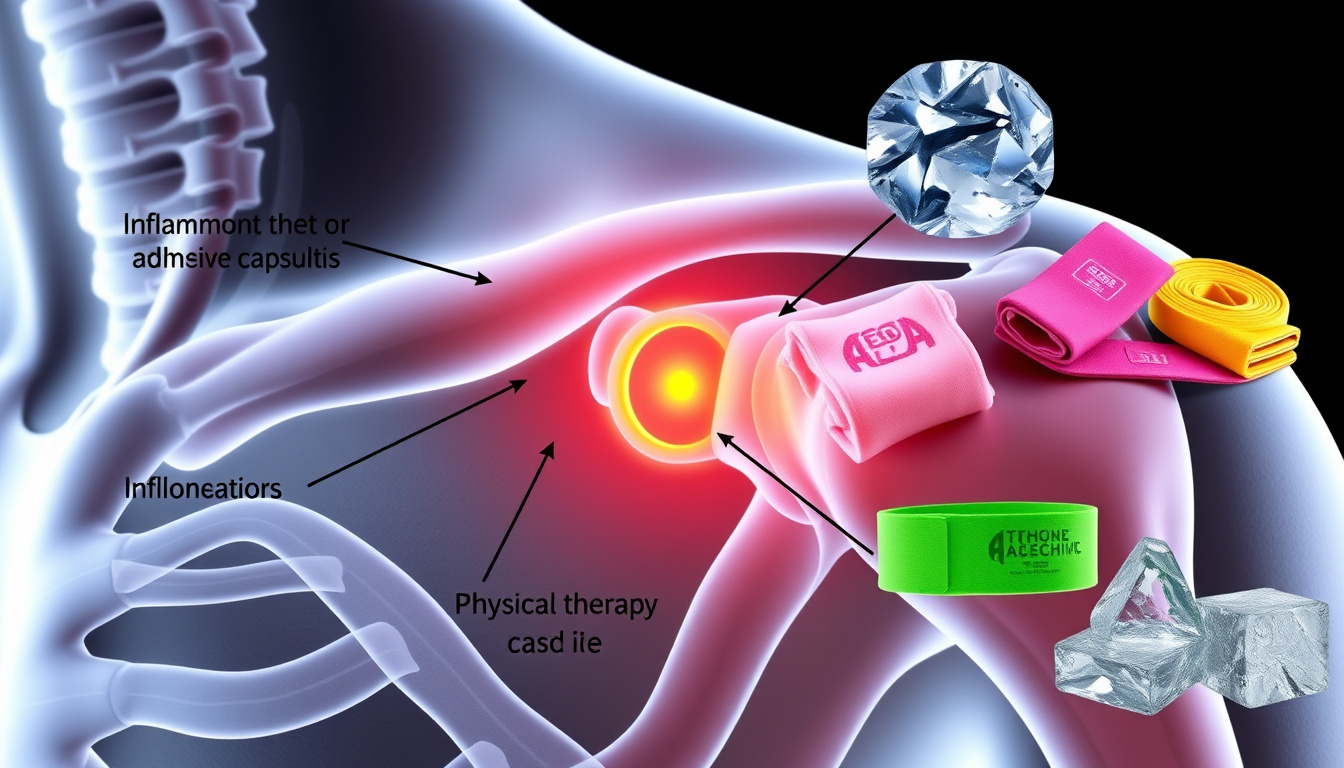
05 Apr Understanding Adhesive Capsulitis: Causes, Symptoms, and Effective Treatments
Adhesive capsulitis, commonly known as frozen shoulder, is a condition that can significantly impact one’s quality of life by causing pain and restricting mobility in the shoulder joint. It typically develops gradually, often without a clear cause, but understanding its underlying mechanisms, symptoms, and effective treatments is essential for anyone who may be affected by this condition. In this article, we will delve into the various aspects of adhesive capsulitis, including its causes, key symptoms to look out for, diagnosis methods, as well as effective treatment and management strategies that can help alleviate discomfort and restore shoulder function.

Key Takeaways
- Adhesive capsulitis, commonly known as frozen shoulder, is characterized by stiffness and pain in the shoulder joint.
- Common causes include injury, surgery, and certain health conditions like diabetes and thyroid issues.
- Symptoms typically involve gradual onset of shoulder pain and limited range of motion.
- Diagnosis usually involves a physical examination and imaging tests to assess shoulder movement.
- Effective treatments range from physical therapy to corticosteroid injections, with preventive measures focusing on maintaining shoulder mobility.
What is Adhesive Capsulitis?
Adhesive capsulitis, commonly known as frozen shoulder, is a condition characterized by stiffness and pain in the shoulder joint, which occurs when the connective tissue around the shoulder joint becomes inflamed and thickens, causing restricted movement. People with adhesive capsulitis often experience three distinct phases: the freezing phase, where pain gradually increases and movement decreases; the frozen phase, characterized by severe stiffness and limited range of motion; and the thawing phase, during which shoulder mobility gradually improves. Both men and women can be affected, with a higher incidence seen in individuals aged 40 to
60. The exact cause of adhesive capsulitis remains unclear, but it is often associated with other medical conditions such as diabetes, thyroid disorders, and previous shoulder injuries. Early diagnosis and treatment are crucial to alleviating symptoms and restoring shoulder function, which may include physical therapy, medications, and in some cases, surgery.
Common Causes of Adhesive Capsulitis
Adhesive capsulitis, commonly known as frozen shoulder, is a condition characterized by stiffness and pain in the shoulder joint. Understanding the common causes of adhesive capsulitis can help individuals identify risk factors and seek appropriate treatment. One of the primary triggers is prolonged immobility; for instance, after an injury or surgery, the lack of movement can lead to the development of scar tissue within the shoulder capsule. Additionally, certain medical conditions, such as diabetes, thyroid disorders, and cardiovascular diseases, have been linked to a higher incidence of adhesive capsulitis. Age and gender are also significant factors, with the condition being more prevalent in women over the age of
40. Moreover, various inflammatory conditions and previous shoulder injuries can contribute to the onset of adhesive capsulitis. By recognizing these common causes, individuals diagnosed with or at risk for frozen shoulder can take proactive steps towards recovery and prevention.
‘The body heals with play, the mind heals with laughter, and the spirit heals with joy.’ – Proverb

Symptoms to Watch For
Adhesive capsulitis, commonly known as frozen shoulder, is a condition that can significantly impact one’s mobility and quality of life. Symptoms to watch for include persistent shoulder pain that may worsen at night, stiffness that limits the range of motion, and difficulty performing everyday activities such as reaching overhead or behind the back. Initially, the pain may be mild, but it can escalate over time, leading to a feeling of tightness and immobility in the shoulder joint. Early recognition of these symptoms is crucial, as prompt treatment can help alleviate discomfort and prevent the progression of this debilitating condition. If you notice these signs, it’s important to consult with a healthcare professional for an accurate diagnosis and appropriate management strategies.
Diagnosis of Adhesive Capsulitis
Diagnosis of adhesive capsulitis, commonly known as frozen shoulder, involves a comprehensive approach to evaluate symptoms and rule out other conditions that may mimic its characteristics. The process typically begins with a detailed medical history, where the healthcare provider assesses the patient’s ongoing symptoms, previous shoulder injury, and any associated medical conditions. A physical examination follows, focusing on the range of motion of the shoulder joint, revealing characteristic restrictions in both active and passive movements. Imaging studies, such as X-rays or MRIs, may be employed to confirm the diagnosis and exclude other issues like rotator cuff injuries or arthritis. In some cases, the clinician may perform a diagnostic injection of a local anesthetic into the shoulder joint to assess pain responsiveness, further aiding in the diagnosis of adhesive capsulitis. Early and accurate diagnosis is crucial for effective treatment, as it can significantly impact recovery time and restoration of shoulder mobility.

Effective Treatments and Management Strategies
Adhesive capsulitis, commonly known as frozen shoulder, is a condition characterized by stiffness and pain in the shoulder joint, making daily activities challenging. Effective treatments and management strategies for adhesive capsulitis focus on alleviating pain, restoring movement, and improving the overall function of the shoulder. Physical therapy is often the cornerstone of treatment, incorporating exercises that enhance range of motion and strength. Ice packs and heat therapy can also be beneficial to reduce inflammation and discomfort. In some cases, corticosteroid injections may be recommended to help decrease inflammation and manage pain effectively. Additionally, certain pain medications or anti-inflammatories can be utilized to provide symptomatic relief. For those who do not respond to conservative treatments, surgical options such as manipulation under anesthesia or arthroscopic capsular release may be considered. Combining these approaches can lead to significant improvements in shoulder mobility and quality of life for individuals suffering from adhesive capsulitis.
Preventive Measures and Coping Techniques
Adhesive capsulitis, commonly known as frozen shoulder, can be a debilitating condition that restricts movement and causes significant discomfort. To mitigate the onset of this condition, there are several preventive measures and coping techniques that individuals can adopt. Regularly engaging in shoulder mobility exercises can enhance flexibility and reduce stiffness, making it less likely for the tissue surrounding the shoulder joint to thickening and tighten. Furthermore, maintaining good posture while sitting or standing helps to avoid unnecessary strain on the shoulder. Incorporating stretches and strength training into your fitness routine also significantly aids in keeping the shoulder joint healthy. When dealing with adhesive capsulitis, implementing coping techniques such as heat therapy, guided physical therapy, and pain relief strategies can vastly improve quality of life. Additionally, practicing stress-relief techniques like meditation can help manage discomfort and promote overall well-being during recovery. By proactively acknowledging symptoms and embracing these strategies, individuals can effectively navigate the challenges of adhesive capsulitis.

Sorry, the comment form is closed at this time.